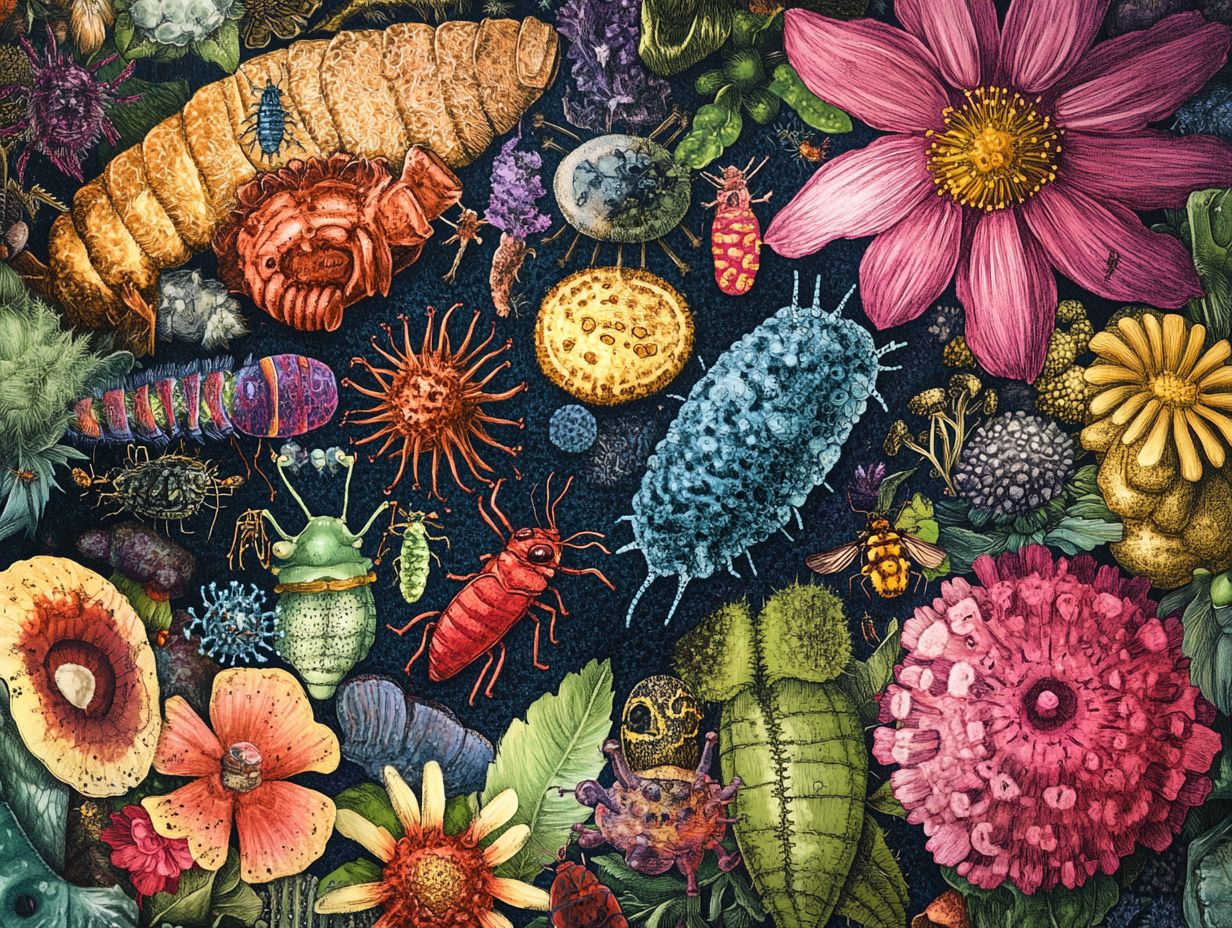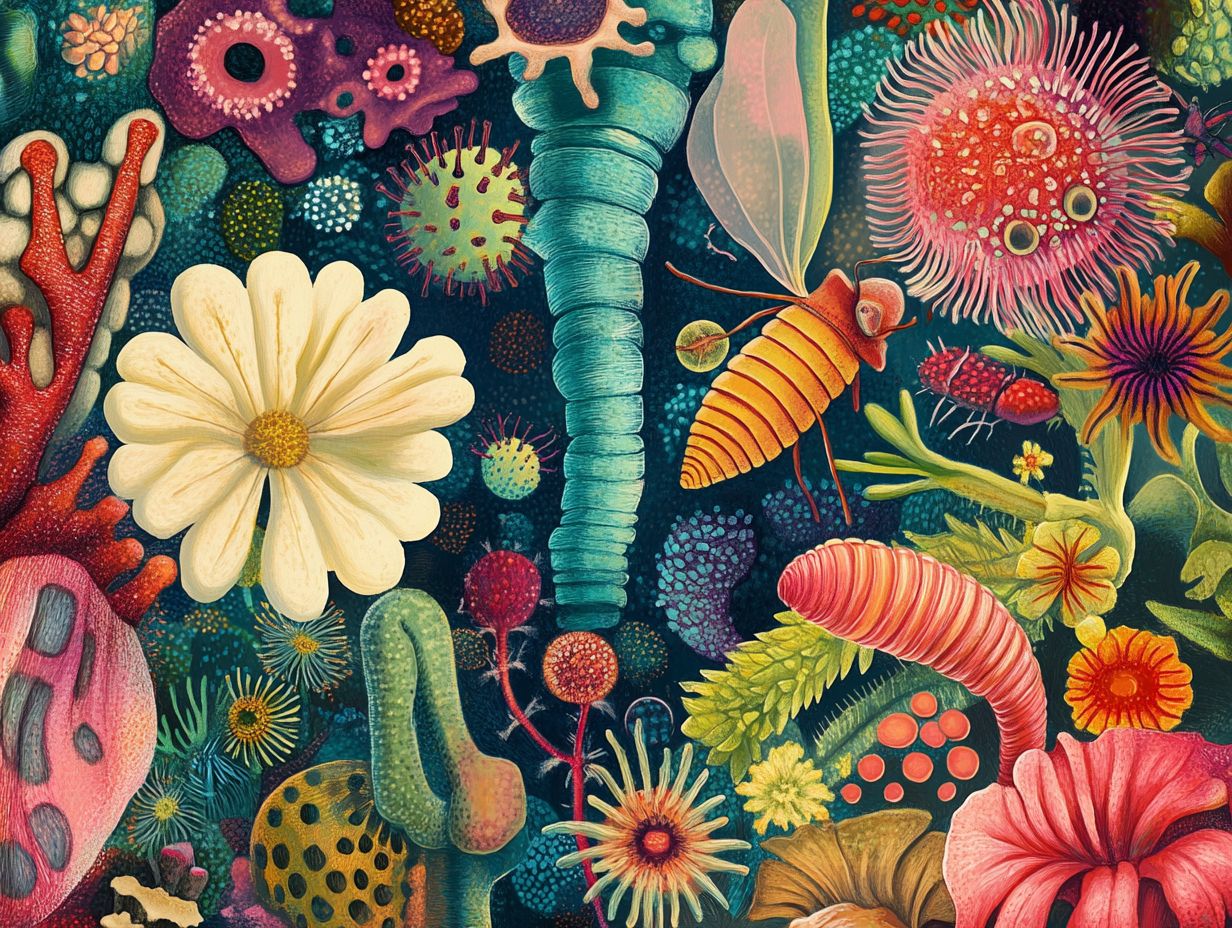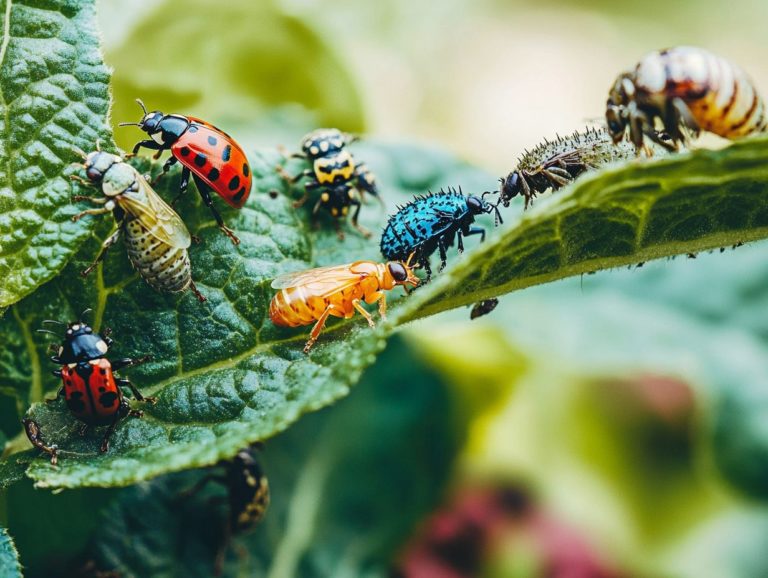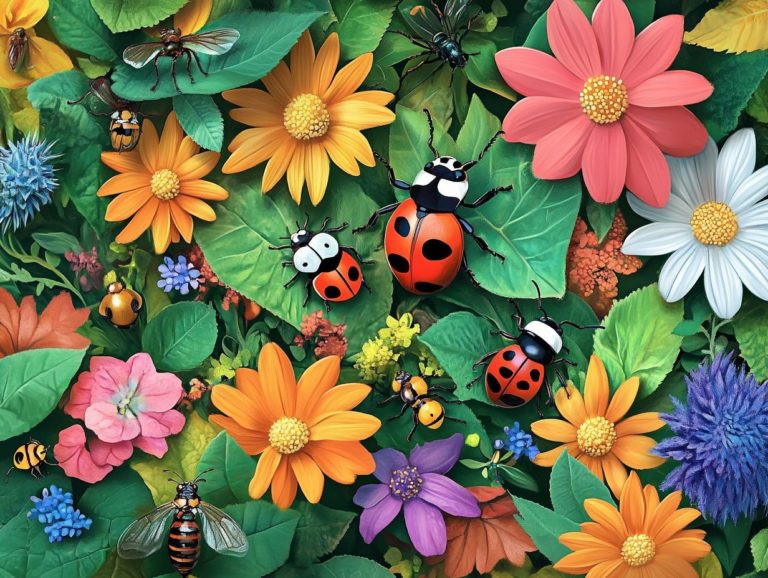The Role of Microorganisms in Pest Control
Microorganisms, often overlooked in the agricultural sector and pest management, serve as the unsung heroes in the realm of pest control.
In this exploration, you will delve into the fascinating world of bacteria, fungi, and nematodes. These minuscule organisms play a pivotal role in managing pest populations, including their role as gut symbionts.
You ll examine the mechanisms by which they operate and weigh their benefits and limitations. This includes the role of biological control and innovative application methods that are reshaping pest management.
Together, you ll look ahead at the future of microbial pest control and its potential impact on sustainable farming practices. Discover how these tiny allies can lead to a more harmonious relationship between agriculture and the environment.
Contents
- Key Takeaways:
- Types of Microorganisms Used in Pest Control
- How Microorganisms Control Pests
- Benefits and Limitations of Microbial Pest Control
- Application of Microbial Pest Control
- Future of Microbial Pest Control
- Frequently Asked Questions
- What is meant by the term “microorganisms” in the context of pest control?
- What role do microorganisms play in pest control?
- How do microorganisms differ from traditional pesticides?
- What types of pests can be controlled using microorganisms?
- Are there any potential drawbacks to using microorganisms in pest control?
- Is the use of microorganisms in pest control safe for humans and the environment?
Key Takeaways:

- Microorganisms play a vital role in controlling pest populations by targeting specific insect pests and leaving beneficial insects unharmed.
- Bacteria, fungi, and nematodes are commonly used microorganisms in pest control due to their effectiveness and low impact on the environment, contributing to biodiversity loss reduction.
- Microbial pest control offers numerous benefits, such as being cost-effective and sustainable, but also has limitations, such as being dependent on specific environmental conditions.
What Are Microorganisms?
Microorganisms like bacteria, fungi, and nematodes are vital in ecosystems. They help plants thrive and fight off pests.
Your understanding of their relationship with plants reveals a fascinating microbial symbiosis. These symbiotic microbes enhance plant defenses against herbivores, including pesky insect pests.
In the world of agriculture, grasping these complex interactions is vital for sustainable practices. They significantly impact crop yield, pest population dynamics, and soil health.
These tiny yet powerful organisms are key to breaking down organic matter, releasing essential nutrients back into the soil. This process supports robust plant growth, including essential amino acids.
Some bacteria, such as Buchnera aphidicola, even engage in nitrogen fixation. This makes this crucial nutrient accessible to crops that might struggle in less fertile environments.
Fungi establish mycorrhizal relationships with plant roots, boosting water and nutrient uptake. Meanwhile, nematodes play a critical role in regulating soil-dwelling pest populations, enhancing overall ecosystem functions.
Beneficial microorganisms can act as natural pest fighters. They reduce reliance on chemical pesticides and promote an ecosystem balance that enhances resilience against insect pests. Preserving microbial diversity is crucial and can lead to a thriving agricultural ecosystem that benefits us all!
Their Role in Pest Control
Microorganisms are essential players in pest control, as they serve as biological agents that introduce natural enemies to the insect pests threatening your crop yield. Understanding the role of microorganisms in soil health can further enhance your gardening practices.
These tiny powerhouses can produce microbial semiochemicals. Some of these compounds deter pest infestations, helping to keep pest populations at manageable levels.
By understanding their contributions, you can enhance your pest management strategies. Utilize tools such as RNA interference and genetic manipulation in agriculture.
These minute yet formidable entities include bacteria, fungi, and viruses that specifically target harmful insect pests. Take Bacillus thuringiensis, for example; this bacterium releases toxins lethal to certain caterpillars and beetles.
It effectively thins their ranks while leaving beneficial insects unharmed. Similarly, fungi like Beauveria bassiana and *Metarhizium anisopliae* can infect and eliminate pest species, adding another layer of natural defense to your crops.
By promoting the use of these microorganisms, you can reduce your reliance on chemical pesticides. This leads to a safer environment and healthier ecosystems.
Their mechanisms not only provide immediate pest control but also contribute to long-term sustainability in your agricultural practices.
Types of Microorganisms Used in Pest Control
In the world of pest control, you ll discover a range of microorganisms that act as potent allies: bacteria, fungi, and nematodes. Each of these plays a unique role within its ecological niche, working diligently to combat insect pests and promote biodiversity.
By harnessing these microorganisms, you gain a natural alternative to chemical insecticides and contribute to enhancing biodiversity. This approach leads to sustainable and environmentally friendly pest management solutions, allowing you to cultivate a healthier ecosystem while tackling environmental challenges.
Bacteria
Bacteria like Bacillus thuringiensis have become noteworthy allies in pest management. They are renowned for their extraordinary ability to target and control insect pests effectively through unique metabolic pathways.
These advancements benefit from new tools like CRISPR/Cas9 technologies. This particular strain produces proteins that are toxic to specific insect larvae, positioning it as an invaluable asset for organic agriculture.
With genetic manipulation, researchers can enhance the effectiveness of Bacillus thuringiensis against a broader spectrum of pests. This method manages pest populations while minimizing the impact on beneficial insects.
This cutting-edge approach champions environmentally friendly pest control methods and holds the promise of reducing reliance on synthetic pesticides. It addresses the rising concerns surrounding ecological health and sustainability.
Fungi

Fungi are powerful allies in pest control. Mycoinsecticides are crafted from fungal pathogens that target specific insect pests while safeguarding beneficial organisms and enhancing plant defenses.
Check out fungi like *Beauveria bassiana* and *Metarhizium anisopliae* that can change the game in pest control! They employ a range of strategies, including infection and toxin production, to effectively undermine pest populations.
These mycoinsecticides play a crucial role in integrated pest management strategies. They contribute to environmental sustainability and allow reductions in reliance on chemical pesticides.
The mycelial networks created by these fungi enhance soil health, improve nutrient cycling, and support robust plant growth. Symbiotic relationships can boost resilience against pests, making fungi invaluable for promoting biodiversity and enhancing ecological interactions.
Nematodes
Entomopathogenic nematodes are specialized microorganisms that serve as effective biological control agents against various insect pests. They play a pivotal role in enhancing soil health and agricultural productivity.
These nematodes thrive in soil and organic matter, infecting and eliminating their hosts through a symbiotic relationship with bacteria. This enhances microbial diversity, aids in pest management, and fosters a balanced ecosystem.
By leveraging these natural predators, you can enhance soil biodiversity, bolster crop resilience, and address nutrient deficiencies while reducing the risk of pesticide resistance.
Their compatibility with other biocontrol methods makes them even more effective. They are crucial in sustainable agricultural strategies that minimize environmental impact while maximizing yield.
By choosing these natural solutions, you re not just fighting pests you re protecting the planet!
How Microorganisms Control Pests
Microorganisms control pests using various sophisticated methods, such as toxin production, resource competition, and disruption of pest physiology. These actions greatly affect how many insects survive.
These mechanisms occur through complex interactions within microbial relationships, including the role of symbiotic microbes that enhance pest management strategies.
Mechanisms of Action
The mechanisms used by microorganisms in pest control are fascinating and diverse. They produce harmful toxins, compete for essential nutrients, and disrupt insect physiology all contributing to increased insect mortality.
The diversity among these microbial agents shows their potential as sustainable pest management tools. Certain bacteria can quickly incapacitate target pests, leading to rapid declines in their populations. This promotes effective pest management strategies.
These microorganisms can outcompete pests for vital resources, effectively starving them and disrupting their life cycles, which contributes to sustainable agriculture. The physiological effects weaken pests’ immune responses, making them more susceptible to environmental stressors, enhancing pest management efficacy.
This multifaceted approach improves pest control effectiveness and fosters a more balanced ecosystem that supports microbial diversity. It reduces reliance on synthetic chemicals and promotes long-term agricultural sustainability, aligning with environmental goals.
Benefits and Limitations of Microbial Pest Control
Microbial pest control offers numerous benefits, including reduced reliance on chemical insecticides, enhanced biodiversity, and support for sustainable agricultural practices.
However, be aware of the limitations, such as varying results and potential ecological disruptions. Considering these factors is vital when developing effective pest management tools tailored to your needs.
Advantages and Disadvantages

The advantages of microbial pest control align with biocontrol strategies, providing environmentally friendly solutions for managing pests. However, you might face disadvantages, such as concerns about economic viability and potential ecological challenges.
This method employs natural organisms like bacteria, fungi, and viruses to specifically target pests while preserving beneficial insects and wildlife. For example, Bacillus thuringiensis (Bt) is a bacterium effective against caterpillar pests in various crops.
While microbial approaches can significantly reduce reliance on chemical pesticides, they may not provide instant results and could require multiple applications, potentially raising cost concerns for you as a farmer.
Case studies from organic agriculture illustrate both the promise and limitations of these techniques, stressing the importance of tailored strategies that fit specific ecological and economic contexts.
Application of Microbial Pest Control
The application of microbial pest control involves various sophisticated methods that harness microorganisms to manage pest populations precisely. This strategy complements modern agricultural practices and integrates with advanced pest management tools.
By leveraging microbial relationships, you can enhance crop resilience while significantly reducing dependence on chemical interventions.
Methods and Techniques
Various application methods for microbial agents in pest management include spraying on the leaves, soil inoculation, and seed treatments. Each method targets specific pests and their ecological nuances.
Before widely implementing these methods, conducting field trials is crucial to evaluate their efficacy and safety.
Foliar sprays involve applying beneficial microbes directly to the foliage, allowing for quick absorption and action against surface-feeding pests.
Soil inoculation incorporates microbial agents into the soil, promoting root colonization and strengthening plant resistance against underground threats like nematodes.
With seed treatments, crops receive protection from the outset of their lifecycle, effectively suppressing pests that might target seedlings.
These techniques aim to reduce pest populations while also striving to minimize environmental impact, highlighting a sustainable approach to modern agricultural practices.
Future of Microbial Pest Control
The future of microbial pest control looks incredibly promising and full of exciting possibilities, propelled by cutting-edge gene-editing technologies like CRISPR and RNA interference.
These advancements make pest management strategies much more precise and effective. They are crucial for protecting our environment and addressing the challenges posed by pest populations in agriculture.
Advancements and Potential Impact
Advancements in biotechnology, including genetic manipulation and a deeper understanding of ecological interactions, are set to transform pest management strategies in agriculture.
These innovations enhance crop yield while effectively addressing the pest challenges of modern agriculture.
The integration of precision agriculture tools like remote sensing and data analytics complements these biotechnological breakthroughs, allowing for real-time monitoring of pest populations.
This data-driven approach gives you the power to implement targeted interventions rather than relying on blanket pesticide applications.
Ultimately, this reduces chemical usage and minimizes environmental impact.
Emerging methods, such as using beneficial insects and bio-based pesticides, signify a shift toward natural solutions aligned with ecological principles.
As these technologies evolve, we can anticipate a future filled with more resilient farming methods that boost productivity while protecting ecosystems, ensuring food security for generations to come.
Frequently Asked Questions

What is meant by the term “microorganisms” in the context of pest control?
Microorganisms refer to tiny living organisms that are too small to be seen with the naked eye, including bacteria, viruses, fungi, and protozoa. They serve as a natural alternative to traditional pesticides in pest control.
What role do microorganisms play in pest control?
Microorganisms control pests in various ways. Some produce toxins harmful to pests, while others compete for resources or disrupt reproductive cycles. Additionally, some microorganisms can attract or repel pests.
How do microorganisms differ from traditional pesticides?
Unlike traditional pesticides, microorganisms are specific to certain pests and do not harm other organisms. They do not leave harmful residues and are less likely to contribute to pesticide resistance.
What types of pests can be controlled using microorganisms?
Microorganisms can control a wide range of pests, including insects, weeds, rodents, and plant diseases, and have been effective in both agricultural and urban pest management.
Are there any potential drawbacks to using microorganisms in pest control?
While microorganisms can be effective, their success may depend on environmental factors like temperature and humidity. Some microorganisms have a short shelf life and require frequent application.
Is the use of microorganisms in pest control safe for humans and the environment?
Using microorganisms for pest control can protect our health and the planet!
To reduce any risks, always follow the handling and application instructions.






